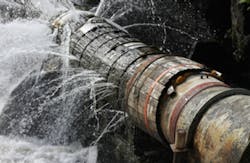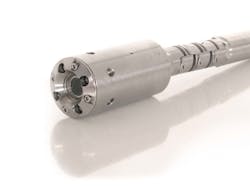Pipe investigations can lower nonrevenue water loss
With the new construction and rehabilitation era booming, technologies are advancing quickly to keep up with the high demand for new and better solutions. Engineers and manufacturers are at the forefront of nondestructive testing, closed-circuit television and acoustic technology that provide pipeline assessment and inspection, some of which are being used to recover nonrevenue water — an issue plaguing the U.S.’s outdated, and sometimes newly installed, infrastructure.
Nonrevenue water is water lost because of leaks, poor maintenance or theft after being produced and before reaching the consumer. Nonrevenue water can be broken down into the following categories: unauthorized consumption through theft, losses through metering inaccuracies and real losses resulting from water leaks and main breaks.
*Photos courtesy of JD7
Investigators have found a leak in 77 percent of insertions.
Assessment and inspection
Pipeline assessment and inspection are proactive approaches for the utility sector, identifying the best ways to prioritize budgets for renewing systems and managing assets. Pipelines span for miles and are constantly at work delivering natural resources to homes and businesses worldwide. The consequences of mismanaging these systems come with many repercussions, including nonrevenue water.
Some of the nation’s existing water and gas pipelines are in the rehabilitation phase and should be inspected to ensure efficient operation. Regular condition assessments and inspection programs help ensure that this infrastructure is functioning efficiently and safely and water revenue is not being lost.
With the newest technology for inspection and assessment available, end users can investigate pipe wall conditions, material validation, sediment issues, blockages, contamination and quality issues, and even project pipe life expectancy. Addressing these issues can help recover nonrevenue water.
Global nonrevenue water loss costs utilities up to $14 billion each year. According to The New York Times, New York City’s water supply system loses 36 million gallons of water per day because of leaks.
*Photos courtesy of JD7
This technology is globally used for water, gas and industrial pipeline investigations.
Addressing aging infrastructure
The inspection and renewal of aging infrastructure, which can date back more than 100 years ago, are critical. Repairing the infrastructure is not cheap, but properly managing assets can help lighten the blow.
Addressing aging water infrastructure assets before they fail maintains productivity and limits disruptive liabilities. By treating all decisions for inspection and renewal as investment decisions, utilities can maximize finances to fund the right projects at the right times.
Last year in Los Angeles, a water main estimated to be 93 years old broke open, causing severe flooding on UCLA’s campus. Incidents such as this are occurring across the U.S.
Sidebar: Pipeline assessment technology benefits
- Life expectancy through true measurements
- Leak detection (water and gas)
- Main renewal prioritization
- Justification and certification of fire mains
- GPS tracking and plotting
- Live video feed
- Location of services, defects and restrictions
- Accurate geographic information system (GIS) mapping
- Material validation
Reducing nonrevenue water with leak detection
Leak detection plays a key role in reducing nonrevenue water because it allows utilities to optimize their system performance by surveying distribution mains (and other systems). Utilities can lower repair costs by finding and repairing leaks before a costly main break.
Because of the technology’s ability to operate under a live main’s pressure to pinpoint leaks, the number of water main breaks should be much lower, and the recovery of nonrevenue water should be much higher. In the U.S. alone, approximately 240,000 water main breaks occur annually, according to the American Society of Civil Engineers. In addition to inspecting water pipes, these technological advancements can be used to inspect gas mains under full pressure for leaks.
By developing a comprehensive plan with pipeline assessment and inspection technologies to ensure optimal performance, municipalities and utilities can rest assured their systems are performing at their best and that the loss of water and revenue is kept to a minimum.
Alyscia Sutch is the marketing and PR manager for cleantech firm Aquam and its subsidiaries. She has a degree in public relations and works closely with construction, plumbing, mechanical and utility companies who provide infrastructure support, rehabilitation and diagnostics solutions for inside and outside infrastructure renewal.

